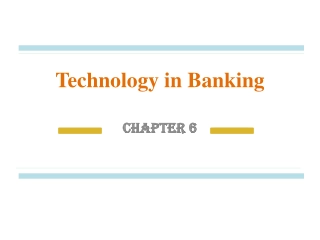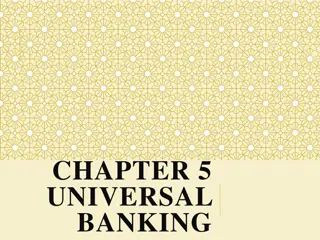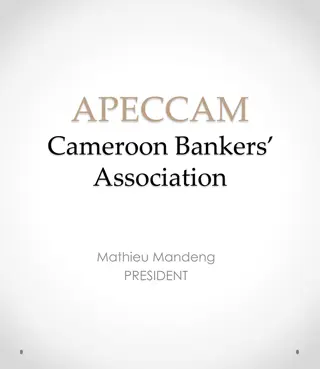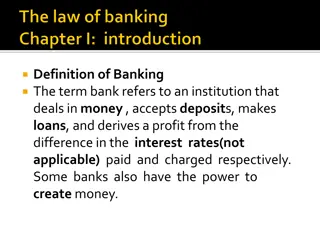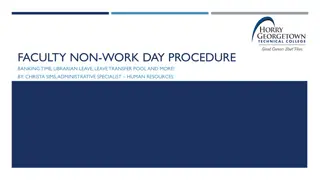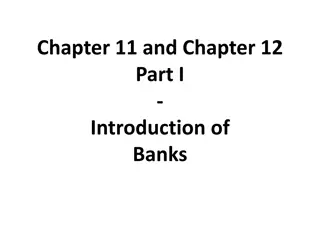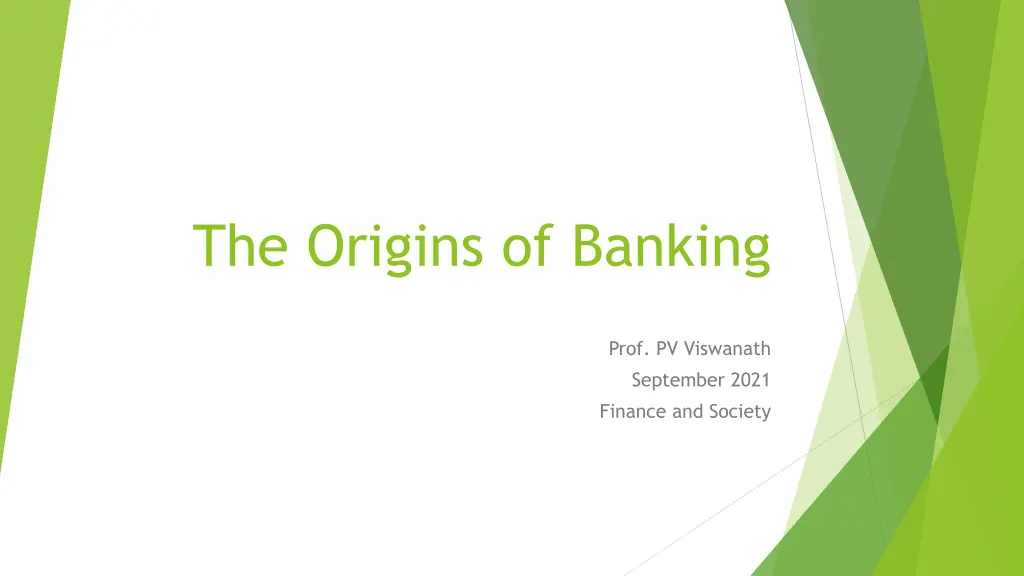
Origins of Banking Activities - Safeguarding Deposits, Bank Notes, Checks
Explore the historical evolution of banking activities, from safeguarding deposits by goldsmiths to the issuance of bank notes and the use of checks as a medium of payment. Learn how these developments shaped the modern banking system we know today.
Uploaded on | 1 Views
Download Presentation

Please find below an Image/Link to download the presentation.
The content on the website is provided AS IS for your information and personal use only. It may not be sold, licensed, or shared on other websites without obtaining consent from the author. If you encounter any issues during the download, it is possible that the publisher has removed the file from their server.
You are allowed to download the files provided on this website for personal or commercial use, subject to the condition that they are used lawfully. All files are the property of their respective owners.
The content on the website is provided AS IS for your information and personal use only. It may not be sold, licensed, or shared on other websites without obtaining consent from the author.
E N D
Presentation Transcript
The Origins of Banking Prof. PV Viswanath September 2021 Finance and Society
Safeguarding Deposits An early banking activity was safeguarding deposits. Wealthy individuals with gold or coins needed to keep it safe. Rather than each individual investing in security (guards), the safekeeping activity could be outsourced to individuals who needed to perform this activity as part of their professional work, i.e. goldsmiths. They would receive receipts, acknowledging the deposits. Initially, these deposits would have been closed deposits, where the banker/goldsmith would return the same gold/coins that had been entrusted to them. For this safekeeping service, a fee would be charged. Over time, these goldsmith/bankers might have started lending out the money to other individuals for compensation, viz. interest. Competition among bankers would have reduced the safe-keeping fee to low levels and even negative levels, i.e. that bankers started paying interest on deposits. At this point, the closed deposit contracts would have changed to irregular deposits, where equal value would be returned to depositors when they wanted their money back, but not necessarily the same coins. Such banking activity occurred as early as ancient 4thcentury Greece.
Bank notes A further development would have occurred when depositors would use the deposit receipts to pay for purchases. As long as the banker was trusted by both parties in the transaction, this would have the advantage of avoiding costly trips to the banker to withdraw the gold/coins and potentially redeposit by the second party with the same or a different banker. Such banking activity and issuance of banknotes existed in 7thcentury Tang and Song dynasties. European banknotes existed in the 17thcentury in Sweden, England and Italy. The acceptance of banknotes assisted in the process of credit creation, since clients were less likely to call in their deposits.
Checks In addition to banknotes (i.e. deposit receipts), checks began to be used. These were essentially orders to a bank to make a payment to a third party. Over time these orders for payments (checks) began to be used as a medium of payment. The initial recipient of the check, instead of going to the banker and asking for gold/coins could simply sign over the order for payment to a fourth party as part of a transaction between these two individuals. Another development occurred when the initial recipient of the payment order would deposit it with his banker for collection from the banker of the initial payor. Since the two bankers were quite likely to have other transactions, instead of the first banker making an actual payment to the second banker, often there would simply be notations on the books of the bankers. This meant that the money stayed within the banking system, if not with a single banker. Again, the likelihood of actual coins having to be paid out dropped further. The proportion of any deposit that was re-lent was even higher now. This is called fractional reserve banking. Over time, regulations required a minimum fractional reserve to ensure that banks did not take excessive risks by over-extending loans, leading to bank runs and consequent credit destruction.
Checks The development of written orders of payment made it practical to transmit large sums of money over substantial distances, which would otherwise be risky. An example of such risk is the shipment by Pope John XXII of 60,000 florins to pay his army in Lombardy. Despite the presence of an armed guard of 150 cavalrymen, the party was ambushed and half of the money was stolen. Previously, the vast majority of financial contracts were oral, taking place with the assistance of witnesses and, from later Roman times, public notaries who kept written records of the contract. They were frequently concluded by the transfer of purchasing power from one depositor to another on the books of their mutual banker, or of their two bankers who could make book transfers between them. One such contract, the cambium, used in the 13thto early 14thcenturies, was a solemn and verbose promise, executed by a notary. The cambium nauticum, or sea exchange contract, was similar, although the payment of the debt in this case was contingent on the safe arrival of the ship. The main feature of these exchange contracts was the receipt of money with a promise to repay at a specified time and place, often in a foreign currency.
The bill of exchange and evasion of usury laws The bill of exchange typically involved four: two principals (e.g., importer and exporter) and two corresponding merchants who effected payment. A bill of exchange consisted of a brief letter from one merchant to the other, requesting that funds on behalf of the importer be paid to the exporter in a distant city (in the distant city s local currency) at a particular future date. A bill of exchange could have arisen as a consequence of a commercial transaction or, alternatively, could have been used to pay off a debt or to transfer money. The typical bill of exchange consisted of two transactions one effectively a short-term loan, and the second a conversion of money from one currency to another. The Catholic Church at various times prohibited the taking of interest, based on the text of the Jewish Bible. However, this could be circumvented in the bill of exchange because the loan was camouflaged by the exchange transaction.
Negotiable bills of exchange Just as banknotes and checks, bills of exchange also came to be exchanged, i.e. negotiated in a secondary market. Negotiability allowed the evolution of written orders of payment from a simple means of transferring funds into a financial instrument which could be priced, traded, and used to move funds for non-trading purposes. In other words, loans taken by one party could be transferred to another, just as bonds today can be sold by one party to another. These developments occurred in the context of trade fairs, which met at regular times of the year and traded in specific commodities at specific locations. Payment for commodities purchased during the several-days long fair with orders for payment which would be settled at the end of the fair using bankers who would be present. Such fairs took place in the region of Champagne, in France from the 9th century to the 14thcentury.
Banking Centers Over time, bills of exchange began to be used, which allowed for money transfers over distances. This also led to the decline of fairs, since part of the motivation for centralization of trade was the centralization of the attendant banking services. Subsequently, banking houses began to be established in centralized locations, such as Bruges and Antwerp in Flanders (Flemish speaking Belgium) and Amsterdam. These locations had the advantages of governing authorities who recognized the importance of finance and provided the legal infrastructure recognizing financial contracts and enforcing their payment. Harreld, Donald. Trading Places: The Public and Private Spaces of Merchants in Sixteenth-Century Antwerp, Journal of Urban History, Vol. 29 No. 6, September 2003 657-669. This was an early instance of finance driving commercial activity. Some of the commodities traded in Antwerp were grain, spices and cloth. One interpretation is that instead of finance following trade, as with the fairs, trade was located in centers such as Antwerp where financing was easily available.
Long-term debt The origins of long-term debt were in the need for states to finance war. Commercial debt, up to this point, had generally been for short periods of time. The absence of long-term debt may have been due to principal-agent problems as well as potential difficulties in collecting the principal, the long- term of the debt increasing the risk too much. In 1156, the Doge, the ruler of Venice levied forced loans from its richest citizens. These loans were soon combined into a single pool of indebtedness, called a monte and the owners of the debt were given shares in this monte. The government continued raising funds through public borrowings of varying maturities. The situation became complex enough that in 1262, the loans were consolidated into a new monte (mountain), which ultimately came to be called the Monte Vecchio (old monte), to distinguish it from newer series of bonds called the Monti (plural of monte) and then a Monte Nuovo (new monte) in 1482. The shares in these monti were traded publicly and their prices rose and fell according to the fortunes of the Venetian government in the different wars and the likelihood of repayment (https://thetchblog.com/2020/05/04/venices-fiscal-restructurings/).
Public Banks Corporate banks also originated in the needs of states to finance their activity. The Bank of Barcelona was created in 1401 as a department of the city government in order to provide credit to the city. Deposits in the bank were guaranteed by the city. Other governments also established banks for various other reasons. The Amsterdam Wisselbank was introduced by the government in 1609 to help bring order to a confused monetary system by establishing a standard monetary unit, economizing on the use of coin, and rationalizing the payments system. At one point, 800 foreign coins were permitted in the Dutch Republic, until in 1638, Amsterdam introduced a standardized silver guilder. In 1694, the Bank of England was established to help the government raise money for war against France. An important point in the establishment of both the First (1791 1811) and Second (1816 36) Banks of the United States was that they would enhance the government s ability to raise funds, as well as promote credit creation and monetary stability. These banks were chartered by the Government, but were not owned by the Government; they were profit-making entities and did not have a monopoly on banknote issuance or other activities, such as banking system regulation, that are now associated with a Central bank.
Banks and Limited Liability Before the development of limited liability commercial banks similar to those we have today, there were many private banks in many countries Australia, Switzerland, Austria, Belgium and others that issued banknotes, made loans to the government, changed money, issued short-term loans and traded securities. These banks tended to be privately owned, often by families, and rarely took in deposits. Over time, however, the needs of commerce required larger banks, which could raise more capital and obtain efficiencies of scale. The corporate form of business organization enables individuals to buy and sell shares in the firm more easily, while limited-liability attracts more capital, since investors private assets are protected. Belgium, which had large supplies of coal and iron ore, needed to raise resources for its capital-intensive heavy industry. Sweden was one of the early countries to industrialize, as was the United States. All of these countries saw the establishment of corporate commercial banks. However, political factors also played a role. The private Bank of England used political pressure to prevent the chartering of additional commercial banks. The collapse of the incorporated South Sea Bubble company in 1720 led to the Bubble Act which discouraged the establishment of limited liability companies.
Summary Incorporated commercial banking emerged as the culmination of several centuries even millennia of development. Starting with the first moneylenders and deposit takers in the ancient world, banking evolved through the development of money, trade credit, medieval fairs, and with the beginnings of the nation-state through the evolution of government banks, and finally private banks. The eighteenth and nineteenth centuries saw the evolution of incorporated commercial banks. Although similar to their predecessors in many of the functions they undertook, the adoption of the corporate form and limited liability allowed commercial banks to become larger, more active players in the growing economies of the eighteenth and nineteenth centuries. There is a clear correlation between economic development and the emergence of commercial banking. Although the association is clear, it need not imply causality: the correlation could be merely coincidental, although there are good reasons to believe that it is not. Each stage of banking development was accompanied by some important advance in political and economic development: public banks and the growth of the nation state, exchange banks, like the Wisselbank, and the growth of domestic trade, and private banks and the growth of interregional and international trade. (p. 53, The Origins of Banking)

